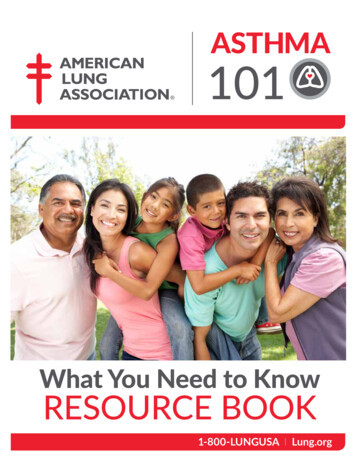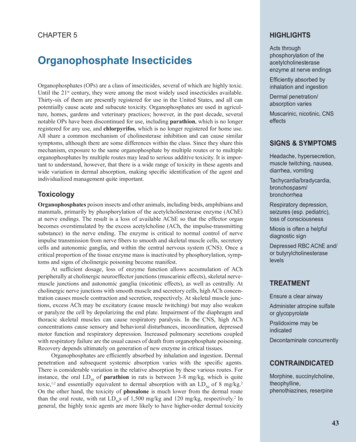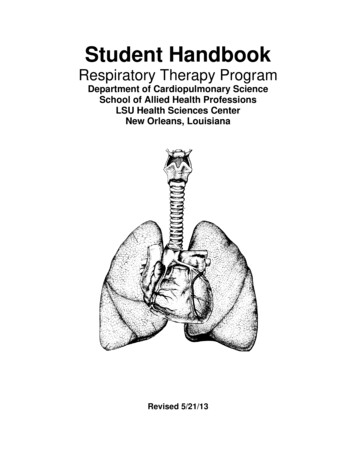
Transcription
Student HandbookRespiratory Therapy ProgramDepartment of Cardiopulmonary ScienceSchool of Allied Health ProfessionsLSU Health Sciences CenterNew Orleans, LouisianaRevised 5/21/13
Table of ContentsIntroduction .Description of the Cardiopulmonary Science Curriculum .Statement of Equal Opportunity Organizational Chart .Respiratory Therapy Program Accreditation .Respiratory Therapy Program Goal and Objectives .Description of the Respiratory Therapy Program andEligibility for National Credentialing Examinations Advanced Placement .Earning CRT and RRT credentials . .Becoming a Licensed Respiratory Therapist .Additional Program Related Costs to Students .Expectations and Guidelines .Grading Policy and Process of Seeking Remediation . .Statement of Satisfactory Academic Progress .Requirements for Special Letter of Completion and Graduation Student Responsibilities and Rights General Policies and Procedures .Guidelines for use of Skills Labs .Illness / Injury Policy .Emergency Disaster Plan .The Clinical Experience .The Student-Clinic Relationship .Clinical Policies and Procedures .Service Work Statement for Students and Clinical Supervisors/Preceptors .Procedure Guidelines for Unsatisfactory Clinical Behavior .Student “At Risk” Incidents Acknowledgment of Policies and Procedures Form .AppendixClinical Guidelines and Rules Sign-off Sheet .Important Addresses .Universal (Standard) Precautions .AARC Respiratory Care Scope of Practice .AARC Statement of Ethics and Professional Conduct . .A Patient’s Bill of Rights .Cardiopulmonary Science Curriculum (Respiratory Track) Clearance for Class/Clinical Form .NBRC Content Outlines: CRT, RRT, CSE .A–1A–2A–3A–5A–6A–7A–9A – 11A – 12111233344445101112131521222224252832343637
IntroductionWelcome to the Department of Cardiopulmonary Science and the Respiratory TherapyProgram! Your acceptance into this program suggests that you are serious about yourstudies and that you are motivated toward establishing a career in the allied healthprofession of respiratory therapy. We the faculty will do everything we can in order tohelp you achieve your goals and become a valuable contributor to patient care. We askthat you take your responsibilities seriously by attending all classes, meeting allassigned deadlines, and respecting the policies and procedures of the RespiratoryTherapy Program.The purpose of this handbook is to give you, the student, a convenient reference forfamiliarizing yourself with the policies and procedures of the Respiratory TherapyProgram. This handbook deals with subjects that are pertinent primarily to our Programand is intended to supplement the official LSU Health Sciences Center (LSUHSC)Catalog/Bulletin, and the School of Allied Health Professions (SAHP) StudentHandbook and orientation packet/materials that are given out to all students atorientation by the Office of Student Affairs. Any policies and procedures set forth in theCatalog/Bulletin, SAHP Student Handbook, or orientation materials have not beenrepeated in this manual. Program academic and clinical policies apply to all studentsand faculty regardless of location of instruction. Although most of the information thatyou need will be located in one of these three sources, should you have any questions,feel free to ask a member of the faculty, who will be happy to assist you.Description of the Cardiopulmonary Science CurriculumThe Department of Cardiopulmonary Science offers a bachelor’s degree inCardiopulmonary Science. The Department provides professional preparation in theallied health specialties of respiratory therapy (including polysomnography) andcardiovascular sonography (cardiac and vascular ultrasound). Applicants choosewhether to enter the respiratory therapy program OR the cardiovascular sonographyprogram. Successful completion of the Cardiopulmonary Science curriculum requirestwo years of study at the LSU Health Sciences Center (LSUHSC) and leads to aBachelor of Science degree in Cardiopulmonary Science.Statement of Equal OpportunityThe LSU System assures equal opportunity for all qualified persons without regard torace, color, religion, sex, sexual orientation, national origin, age, disability, maritalstatus, or veteran's status in the admission to, participation in, or employment in theprograms and activities, which the LSU System operates. The Department ofCardiopulmonary Science adheres to this policy in its admissions to, participation in, oremployment in the Department of Cardiopulmonary Science.1
LSUHSCDepartment of Cardiopulmonary ScienceRespiratory Therapy ProgramChancellor, LSU Health Sciences CenterLarry H. Hollier, MDDean, School of Allied Health ProfessionsJ.M. Cairo, PhDAssociate Dean forAcademic AffairsJohn Dolan, RhDAssistant to the Dean for Clinical AffairsElizabeth Levitzky, MBAAssistant Dean forFiscal AffairsJoseph Lassalle, IIIDirector of Office of Student AffairsYudialys Delgado, BSDepartment Head, Department ofCardiopulmonary ScienceAndy Pellett, PhD, RDCSMedical DirectorCarol Mason, MDProgram Director forAdvanced Respiratory TherapyJohn Zamjahn, PhD, RRTDirector of Clinical Education forRespiratory TherapyTim Cordes, MHS, RRT, NPSPart TimeDidactic / Laboratory FacultyTerry Forrette, MHS, RRTProgramAdvisory CommitteeRepresentatives of (minimum):StudentsGraduatesFacultySponsor AdministrationEmployersPhysiciansPublicClinical Affiliates / Program Site CoordinatorsAccess Respiratory Homecare Sleep & Wellness CenterAnna Campo, BS, RRT, RCPKristen McGoeyAdministrative AssistantBaton Rouge General Medical CenterChris Albright, BS, RRTChildren’s HospitalDawn B. Bordelon, B.S., RRTEast Jefferson General HospitalSusan Bailey, BS, RRTDanny Schellhaas, RRTEarl K. Long Medical Center/LSUHSCJames Morris, BS, RRTLSU Interim Public HospitalOur Lady of the Lake – LSUHSCConsortium Program for RespiratoryTherapySue Davis, MHS, RRTKendall Beasley, BS, RRTJohnny D’Aquin, RRT, RPFTDavid Doyle, BS, RRT, CPFTNorth Oaks Medical CenterWendy Herring, RRTLawrence Balado, RRTOur Lady of the Lake Regional Medical CenterCrystal D. Barkemeyer, BS, RRTSoutheast Louisiana Veterans Health Care SystemJennifer Whitney, RRTSt. Tammany Parish HospitalBrett Stafford, BS, RRTTouro InfirmaryLarry Anderson, RRTTulane University Medical CenterChristopher Hakenjos, BS, RRTCarl Romero, MBA, BS, RRTWest Jefferson Medical CenterJules Poirier, RRTWoman’s HospitalDanette M. Legendre, RRT-NPS2
Respiratory Therapy Program AccreditationThe Respiratory Therapy Program is accredited by the Commission on Accreditation forRespiratory Care (CoARC). The Program’s accreditation is for a period of 10 years from11/30/2011to 11/30/2021. Our CoARC Program Reference # is 200251. The Programis not accredited in polysomnography.Commission on Accreditation for Respiratory Care1248 Harwood RoadBedford, TX 76021-4244Phone: 817.283.2835; Fax: 817.354.8519http://www.coarc.com/Respiratory Therapy Program Goal and ObjectivesGoal: To prepare graduates with demonstrated competence in the cognitive(knowledge), psychomotor (skills), and affective (behavior) learning domains ofrespiratory care practice as performed by registered respiratory therapists (RRTs).Upon completion of the program, graduates will be competent Registered RespiratoryTherapists.Objective 1: Upon completion of the program, graduates will demonstrate the ability tocomprehend, apply, and evaluate clinical information relevant to their roles asadvanced-level respiratory therapists.Objective 2: Upon completion of the program, graduates will demonstrate the technicalproficiency in all skills necessary to fulfill their roles as advanced-level respiratorytherapists.Objective 3: Upon completion of the program, graduates will demonstrate personalbehavior consistent with professional and employer expectations for advanced-levelrespiratory therapists.Description of the Respiratory Therapy Program andEligibility for National Credentialing ExaminationsThe Respiratory Therapy Program involves didactic and laboratory instruction inrespiratory therapy that is supplemented with clinical experience in every semesterexcept the first. Upon successful completion of 19 months of study, each studentreceives a Special Letter of Completion issued by CoARC stating that the student hassuccessfully completed the courses approved by CoARC and has met the requirementsfor this special letter of completion in lieu of the National Board for Respiratory Care’s(NBRC, http://www.nbrc.org/) graduation and degree requirement in respiratory therapy.With this letter, the student is eligible for the Certified Respiratory Therapist (CRT) andRegistered Respiratory Therapist (RRT) examinations. Thus, when registering for these3
exams you are considered a student enrolled in an accredited respiratory therapyeducation program in an institution offering a baccalaureate degree and have beenawarded a special certificate of completion approved by the CoARC. After completingthe Respiratory Therapy Program, students take an additional semester (5 months) ofcourses that includes polysomnography to earn a bachelor’s degree in CardiopulmonaryScience. Students are strongly encouraged to take the CRT and written portion ofthe RRT examination during the break between the fall semester and the finalspring semester.Advanced PlacementThe Department’s program in respiratory therapy does NOT offer advanced placement.Earning CRT and RRT CredentialsFollowing successful completion of the CRT examination, one earns the CRT credentialand is recognized as a certified respiratory therapist and becomes eligible to take theRRT examination. Likewise, after successful completion of the RRT examination, oneearns the RRT credential and is recognized as a registered respiratory therapist. TheRRT examination consists of a written part and a clinical simulations part. You may takethem in any order, but both parts must be passed to earn the RRT credential. The CRTand RRT credential must be earned within three years of completing the respiratorytherapy program. Individuals whose three-year time limit has expired must retake andpass the CRT Examination to reinstate their eligibility for the RRT Examination.Becoming a Licensed Respiratory TherapistIn order to practice respiratory therapy in most states, including Louisiana, one musthold a minimum of a CRT credential and obtain a state respiratory therapy license.Students are encouraged during the months leading up to receiving their special letterof completion to start the application process with the Louisiana State Board of MedicalExaminers (LSBME, http://www.lsbme.louisiana.gov/) to become a licensed respiratorytherapist (LRT). A felony conviction may affect a graduate’s ability to sit for the NBRCexaminations or attain state licensure.Additional Program Related Costs to StudentsRequiredApproximate Costs Textbooks and lab supplies Clinical background check and supplies (i.e., scrubs,stethoscope, bandage scissors, hemostat, and safety goggles) LSUSC Parking and gate card Basic Life Support (BLS), Advanced Cardiac Life Support (ACLS),Pediatric Advanced Life Support (PALS) Provider cards 1500 250 90 234
CRT/RRT Review course Diploma, Cap and Gown 70 47Profession Related NBRC CRT examinationNBRC RRT examination (written portion/clinical simulations portion)Each NBRC credentialing exam (CPFT, RPFT, NPS, SDS, ACCS)Renewal of AARC Membership (before/after graduation date)Louisiana State Respiratory Care Conference and ExhibitsRegistration (Student-AARC Member/-Non-ARRC Member) Louisiana Respiratory Therapy licensure fee/renewal 190 190/ 200 200- 300 50/ 90 0/ 65 125/85Expectations and GuidelinesAcceptance into the Cardiopulmonary Science Bachelor of Science Degree Program atLSU Health Sciences Center - New Orleans indicates that the faculty and staff in theDepartment of Cardiopulmonary Science have chosen to dedicate their time, effort andexpertise to train you to become an allied health practitioner. Your acceptance of ourinvitation to enter the program indicates that you are committed to becoming aprofessional in the cardiopulmonary sciences by fulfilling the degree requirements andtaking all the appropriate board exams. Your acceptance also marks the beginning ofan intense two-year didactic and clinical preparation to become a competent and caringprofessional in respiratory therapy. Successful completion of the Program demands thefullest commitment of time, effort and energy from all parties involved. This sectionoutlines the specific qualities, attributes and learning strategies required of a successfulstudent in the Program, and further serves to define resources and references you mayneed throughout your course of study as well as those you may need in your career asa professional in the cardiopulmonary sciences.I. Transitioning to ProfessionalismYour tenure as a student in the Department of Cardiopulmonary Science will beunlike your past educational experiences. Unlike the general curriculum required formost bachelor’s degrees, your coursework will be streamlined and specialized to thecardiopulmonary sciences and will traverse classroom examination to demonstrationof competency in clinical settings. The most successful graduates from theCardiopulmonary Science Program demonstrate a triad of qualities includingprofessional decorum, professional integrity, and educational leadership. Theintegrated incorporation of these qualities eases the transition from college studentto health care professional.a. Professional DecorumFirst impressions go a long way in determining how one is perceived and treatedin the classroom and in the clinic. In order to earn respect on both a professional5
and personal level, one must project the appearance of a competentprofessional. Arriving on time or early demonstrates that you understand andrespect the importance of your attendance in both the clinic and the classroom.Health care professionals should be well groomed, dressed in the appropriateattire, and prepared for the task at hand whether it be classroom activities(books, assignments, prior readings, etc.) or in the clinic (lab coat, scissors, blackpen, stethoscope, etc.). Students should also be respectful of those who may besensitive to strong odors by limiting the use of scented products (i.e. colognes,lotions, cigarette smoke, etc.). Taken together, these guidelines define theprofessional decorum expected of each student enrolled in the Department ofCardiopulmonary Science as they pertain to both the classroom and clinicalenvironments.As a student, you are expected to: Arrive on timeBe well-groomed (both your person and your property)Dress in the appropriate attireHave the needed materials/equipmentWear your Identification Badge (on campus an in clinics)b. Professional IntegrityAs a respiratory therapist, your professional success will be determined in part byyour professional integrity. The successful student is one who possesseseffective communication skills, is self-directed and willingly participates in allaspects of the educational process. These students demonstrate great respectfor themselves, their professors and colleagues; they are honest and embraceclinical practice with ethical and moral standards. Furthermore, these studentsare admired by those with whom they interact for their sympathetic andempathetic standard of care in the clinical setting.As a student, you are expected to: Utilize effective social and communication skillsBe self directed and motivated in your studies and in clinicDemonstrate respect for yourself, the faculty and staff, and your peersProvide sympathetic and empathetic carec. Educational LeadershipYour proficiency as a respiratory therapist will also be evaluated on youreducational leadership. The most successful professionals not only understandand are proficient at the “how” of the tasks in their field, but also understand the“why” behind the actions on a fundamental level. It is not enough to memorize thematerial presented; students must possess an understanding of the material6
beyond recall. Such understanding of fundamental procedures and diseaseprocesses allows a professional to make the most informed decisions andanticipate realistic outcomes and complications in patient care. Furthermore,health care professionals are expected or required to continue their education aftercompletion of the degree program. In fact, it is now the policy of some hospitals torequire continued education (R.R.T., asthma educator, etc.) for advancement.Educational leadership also incorporates the service of the health care professionin that professionals are expected to share their knowledge with otherprofessionals and to participate in the training of students and new staff members.As a student, you are expected to: Master the presented material beyond the recall levelDemonstrate mastery of the fundamental principles and techniquesPursue education outside of the classroomDemonstrate competency in diagnostic and/or therapeutic procedures andpatient careII. A Lifetime of ProfessionalismThere are numerous opportunities available for students to develop theirprofessionalism.These include participation in Camp Pelican, health fairs,mentoring, membership in professional organizations, attendance at state andnational conferences, and earning the highest credentials in respiratory therapy.a. Camp Pelican ( www.camppelican.org/ )Camp Pelican is a week long summer camp sponsored by Louisiana PulmonaryDisease Camp Incorporated, a non-profit organization founded in 1976 by agroup of respiratory therapists, nurses, and physicians to promote anappreciation of the plight of children with chronic and debilitating lung disease,such as cystic fibrosis, chronic asthma, and children who are ventilator assisted,and many others. Each year our respiratory therapy students are afforded theopportunity to share their technical and personal skills with the community byassisting campers with their specialized routine care 24 hours a day. This is anextremely rewarding experience for both the student and camper.b. MentorshipBy becoming a mentor to your fellow students, you are helping to provide themwith the skills necessary to achieve their highest potential and thus strengtheningyour profession and community. Mentoring can be done silently by setting anexample to others, or mentoring can be hands-on through sharing proven studyskills, time management, knowledge and experience with fellow students. Youshould realize that as seniors, you are constantly mentoring to juniors that willhave profound effects on their professionalism.7
c. Health ScreeningStudents are occasionally asked to help provide health screenings to theLSUHSC network employees or to members of the community. This is anopportunity for students to provide educational information related torespiratory therapy andcardiovascular technology to the community, as wellas gain valuable insight into patient care. Students have the opportunity toparticipate with the American Collegeof Allergy, Asthma, and Immunology inproviding free spirometry testing at the St ThomasCommunityWellnessCenter, as part of National Asthma Awareness Week.d. Membership in Professional OrganizationsMembership in your professional organization is critical to ensure a united, strongvoice that speaks for all its members to advocate for patients in areas of accessto appropriate health care professionals, quality of patient care, and patientservices. The respiratory therapy profession has a national organization calledthe American Association for Respiratory Care (AARC, www.aarc.org/), with anAARC State Society in most states. In Louisiana, the AARC State Society is theLouisiana Society for Respiratory Care (LSRC, www.lsrc.net ). Since 1947, theAARC has been committed to enhancing our professionalism as respiratory carepractitioners, improving our performance on the job, and helping us broaden thescope of knowledge essential to our success.Your support of the AARC and LSRC is integral to the success of the profession.By joining the AARC, you help gain access and strengthen positions andcredibility with lawmakers and administrative agencies. Each of you has theability to both indirectly and directly strengthen the foundation of the respiratoryprofession by becoming a member today. The AARC is dedicated to helping yougrow and develop as a respiratory care professional. They offer news,authoritative and up-to-date information and resources, and provide life-longlearning through continuing education, and career assistance. During the stateand national meetings you will have the opportunity to hear the latest researchregarding the profession, be introduced to new technology and equipment, andnetwork with other professionals from around the nation.e. CredentialingDuring the course of the program, students become eligible to sit for nationalboard exams for respiratory therapy offered by the NBRC (www.nbrc.org). Uponsuccessful completion of the respective exams, they become certified respiratorytherapists and then registered respiratory therapists. Students who hold eitherthe CRT or RRT credential are able to apply for state licensure (www.lsbme.org),which is required to practice respiratory therapy.8
In order to ensure superior health care to patients, health care professionals seekand demonstrate the highest level of competency in their profession. Therespiratory therapist who has demonstrated the highest level of competency intheir profession is the registered respiratory therapist (RRT). As a student of anadvanced respiratory therapy program, you are expected to obtain and performat the highest level of competency as evident by earning the RRT credential. Inaddition to earning the RRT credential, students and therapists can provideleadership and specialized training by becoming an Asthma Educator, Basic LifeSupport Provider and Instructor, Advanced Cardiac Life Support Provider andInstructor, Pediatric Advanced Life Support Provider and Instructor, NeonatalResuscitation Program Provider and Instructor.Therapists often give of their time, knowledge, and expertise to the advancementof their profession by becoming clinical instructors, unit coordinators, shiftsupervisors, and managers. They participate in research, and provide seminars,in-services and continuing education.III. Helpful Hints to Successa. Commit Yourself.No, not to a mental institution, but to truly learning cardiopulmonary sciences.You can’t go about learning respiratory therapy in a halfhearted fashion. In orderto integrate the many concepts of cardiopulmonary sciences you must beaggressive and be devoted to your studies. This may mean spending less timewith family, friends, and co-workers and more time with fellow students, faculty,and patients.b. Ask Yourself Why.Whenever possible, ask yourself why something is the way that it is, or happensthe way that it does. If you are unsure of the answer, ask the instructor. Thismethod will help you remember and integrate material, and increase your level ofunderstanding. The beauty of respiratory therapy is that so much of thephysiology, pathophysiology, diagnostic techniques, and treatment modalitiesmake sense. If something does not make perfect sense to you, make everyeffort to see that it does. Do not simply give in and memorize the material.c. Take Responsibility for What You Don’t Know.If you don’t understand something, and you are like most students, you will doone of two things. You can forget about the material, attempt to learn it the daybefore the test when it is too late, completely botch it on the exam, and thenblame the teacher for not explaining it to your satisfaction. Better yet, you canask the teacher, preferably on the day of the lecture, about the material that youdon’t understand. The teacher is here to help you, so take advantage of his or9
her knowledge. You cannot and must not be afraid of asking questions. You’repaying for this, so get your money’s worth.d. Focus on the Material, Not on the Exam.In order to make your time here a rewarding and enjoyable (well, at least lessstressful) experience, your goal must be to learn the material, not just pass theexams. The primary purpose of the exams is to get you to study. If you workhard and dedicate yourself to learning the material, the exams will take care ofthemselves. Do not continually ask, “Do we need to know this for the test?” Ifyou familiarize yourself with everything presented in class, as well as eachreference indicated by the instructor, you will do well.e. Do Not Cram.If you enjoy headaches, then by all means study the material at the last minute.However, if you want to reduce stress in your life, keep up with the material!Grading Policy and Process of Seeking RemediationThe Department of Cardiopulmonary Science employs the following grading policy forall didactic courses:A 90-100%B 80-89%C 70-79%D 60-69%The minimum passing grade is a C. Clinical courses are pass/fail. Any courses in whichthe student receives less than a “C” in a graded course or an “F” in a pass/fail coursemust be repeated, and a grade of “C” or higher or “P” earned, before the sequence canbe continued. Additional information regarding grading of clinical courses is in theClinical Policies and Procedures section of this handbook. Policy and ProceduresRelating to Academic Misconduct are in the LSUHSC Catalog/Bulletin,http://www.lsuhsc.edu/catalog/ and SAHP Student Handbook.Course syllabi provide specific guidelines on examinations. Faculty members administerand review for exams at their discretion. Exams are returned to students for review anddiscussion and then collected during the same class period. Students are encouragedto keep a record of their exam performances. A student may review their gradesacquired during a course either by scheduling a meeting with the course director or byusing the online secure course management system (Moodle).A student who receives a failing grade on an exam is strongly encouraged toseek immediate guidance from the course director on possible means forimproving his/her performance. These may include scheduled meetings with thecourse director or instructional faculty, seeking out tutoring, additional practiceassignments and/or practice time. Students seeking guidance should make an10
appointment with the appropriate course director and refer to the Appointments withFaculty Members section of this handbook.Statement of Satisfactory Academic ProgressThe following requirements pertaining to the status of satisfactory academic progressapply to all students enrolled in the Department of Cardiopulmonary Science. In order toachieve the status of satisfactory academic progress the student must satisfy thefollowing standards:1. Maintain a grade-point average that is consistent with the academic standardsset by the Department’s grading policy.2. Satisfactorily complete the required number of credit hours per semesterestablished by the Department.3. *Meet the LSUHSC, SAHP health requirement related to hepatitis vaccine seriesand annual tuberculin skin test.4. *Maintain current certification in CPR for Health Professionals.5. Completed required compliance training.6. Meet the technical standards of the Cardiopulmonary Science Program asdefined in the LSUHSC Catalog.7. Satisfactorily complete all course work required for graduation in not more thaneight calendar years.*Students are required to submit evidence of compliance with all health requirements tothe Student Health Services and Records (Lions Building, Rm 716, 2020 Gravier St.)and CPR compliance to the Program’s Director of Clinical Education. Students arerequired to complete required on-line compliance training through the Office ofCompliance. The Assistant to the Dean for Clinical Affairs will inform the DepartmentHead when students are in noncompliance. The Office of Compliance notifies studentswhen they are not in compliance and instructs them on how to complete the requiredtraining. Students cannot enroll in semester courses until evidence of compliance iscurrent. If a student comes due for one of the requirements during a semester, he/shemust comply before continuing participation in semester coursework or clinical rotations.In order to determine that a respiratory therapy student can safely apply modalities anddata collection techniques on patients in the clinic, the student must demonstratecompetency in the laboratory. These competencies combine and integrateassessments, behaviors and treatment procedures reflective of respiratory therapypractice. These competencies are graded either pass or fail. Competencies that thestudent must demonstrate are listed in respective course syllabi. Students are requiredto practice skills and pass a competency test on each procedure taught in therespective semester. Competency evaluations are comprehensive and any competencypreviously tested may be included in course practical exams. In the event that thestudent fails a competency evaluation, the student is required to continue to practice theskill until the evaluation is passed. Students must pass all competencies in order topass the course in which the competencies are based. The student will not be allowed11
to attend clinic until successfully
Louisiana Respiratory Therapy licensure fee/renewal 125/85 Expectations and Guidelines Acceptance into the Cardiopulmonary Science Bachelor of Science Degree Program at LSU Health Sciences Center - New Orleans indicates that the faculty and staff in the Department of Cardiopulmonary Science have chosen to dedicate their time, effort and
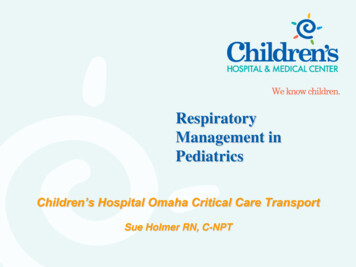
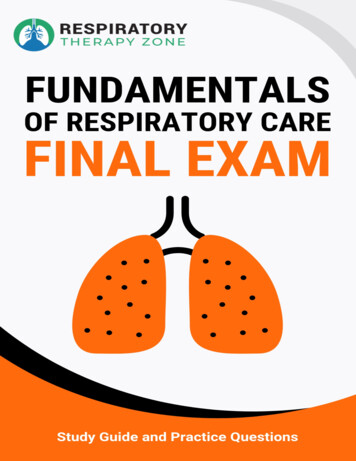
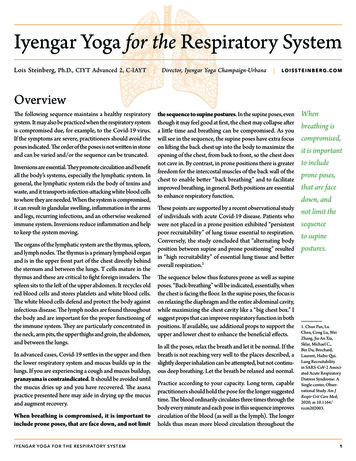
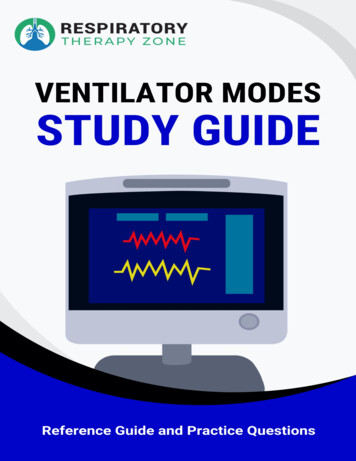
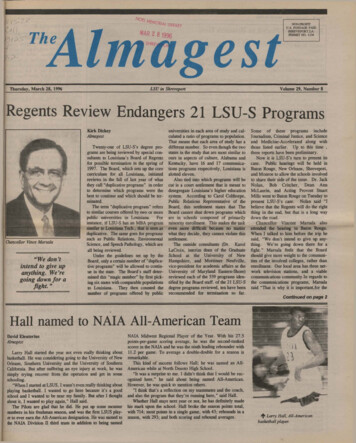
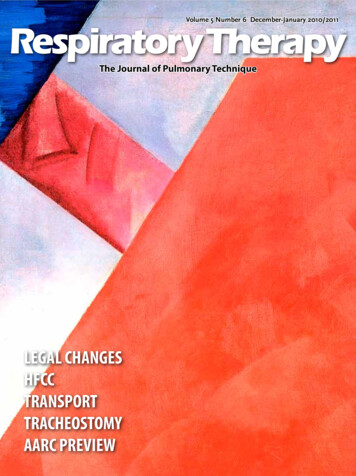
![Respiratory Therapy Training for Long-Term Care Nurses [Read-Only]](/img/29/handout-respiratory-20therapy-20training-20for-20long-term-20care-20nurses.jpg)

